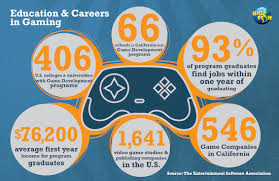Game On: Careers in Video Game Development

image courtesy of Google images
March 31, 2017
Video games have come quite a long way from 1958. What started as a simple tennis simulator that was a hit at the National Brookhaven Laboratory’s open house has expanded into a massive entertainment industry on par with giants like the film and recording industries. Video games have become a huge part of many people’s lives, memories, and identities. Due to just how rapidly they have grown, many people have an interest in working in this rising industry themselves.
But what does one have to do to work in the video game industry? It’s not all fun and games- while a passion and love for gaming is certainly a plus, there is much more that one will have to accomplish if they wish to create that which they love. Full Sail University breaks down the games industry into three main roles: art, design, and development. The art field is comprised of concept artists, 3D modelers, spriters, and animators. They are what make video games a visual medium- they created everything from Mario’s timeless design to the massive open landscapes of Skyrim. Design is what makes a game fun to play. They research just what makes a game good on all levels- audio, visual, gameplay, and every other facet a player will see, hear, or feel. They are the ones with the ideas, the ones who design how a game will play and what the story and characters will be. And finally, there is development. Art may make a game look pretty and design may create great concepts and ideas, but it is the developers who make the game actually work. They program and code the games, create AI for the characters, ensure that the games are as glitch-free as possible, and do much more.
To get into one of these fields, one must first decide which one is right for them. Art is of course a very respectable field to go into for any artists. Design is suited to creative minds more geared towards writing than the visual arts as well as dreamers with big ideas. Development is a very good field for people skilled with math, numbers, and logical problems. It is also the largest piece of the games industry due to its colossal scope and size.
Getting into the art field is the easiest in theory- one simply needs to be a skilled artist with an understanding of the art style and tone of the game they intend to work on. However, being an artist is not easy in practice. While many people love art, the amount of people who are truly skilled at creating it is lower. And even lower than that is the amount of people who can put out good art on a tight deadline without compromising quality. But if someone fills these requirements, they simply need to look for job openings to submit their portfolio too- after all, the most important prerequisites to becoming a professional artist are talent and timeliness, not industrial experience. But like any artist, expect a long cycle of feast and famine before you land your first long-term gig in the industry.
Design, in contrast, is much probably the most difficult in both theory and practice. Most game designers end up in the indie games industry, working on their own games without a larger company. This is because most large game companies already have designers. And if they are hiring, they usually want someone with experience on other big games. This leads to the problem of the field easily becoming an industry veterans only club, which is a real tragedy for many aspiring designers with grand ideas and ambitions. However, if someone has enough drive, talent, and ways to keep themselves fed until their product is done, they can make their own game by themselves or with a small team. And this industry has proven very profitable- the game Minecraft started out independent, but became a massive hit that quickly became a juggernaut of the industry for younger audiences. Some colleges also offer courses in game design- while many people know what they like in games, it takes a bit more to understand what makes these games special and worth playing. With a good education, one can come to understand the principles of game design that have made the greats so popular.
Game development is the largest field and consequently the one with the most job offerings. Engineering, programming, coding, and AI design are all growing fields with increasing needs for manpower. Even if one does not make it in the gaming industry with these talents, they are sure to find work elsewhere. This certainly requires years of education to master, but will be certain to pay talented workers well. Also, it is less of a “veteran’s club” than design, mostly because game companies are almost always in need of more hands on deck to work on their games in these departments- industrial experience cannot be expected from every new team member- only skill.
So while video games may still be seen as a child’s pastime by many stubborn people of older generations, they have spawned a massive growing international industry with many job opportunities across the globe. It may not be all fun and games for the people who want to work on the same type of entertainment that has created so much joy for them, but in the end anyone can follow their dreams should they possess the drive, persistence, and skills to get them through all the hardships along the way.

